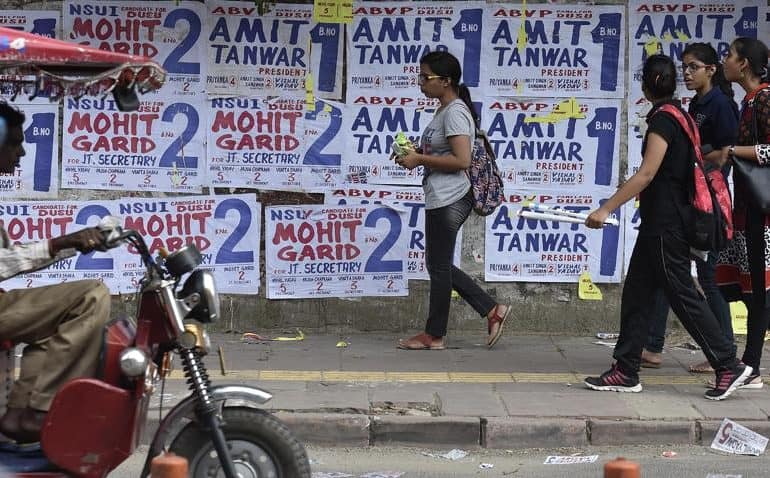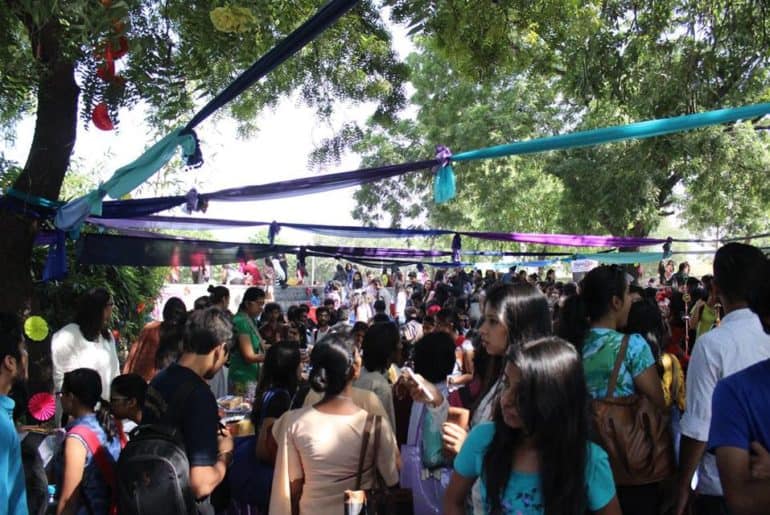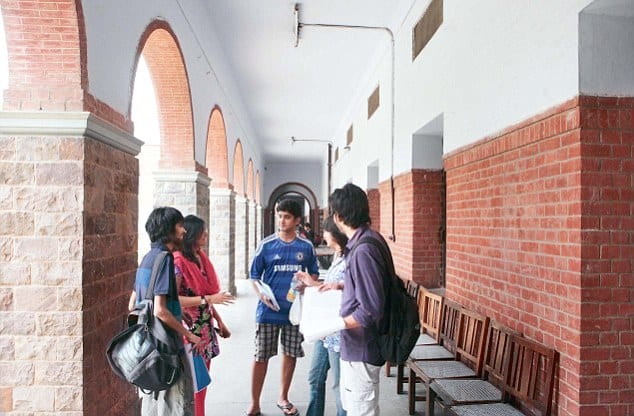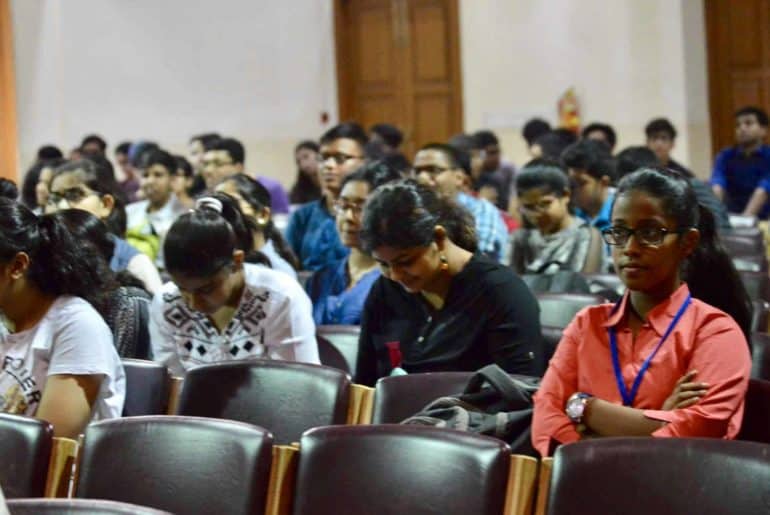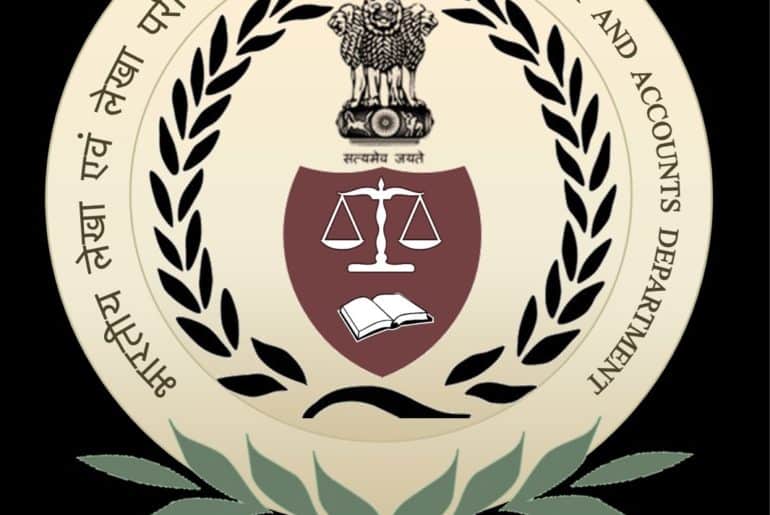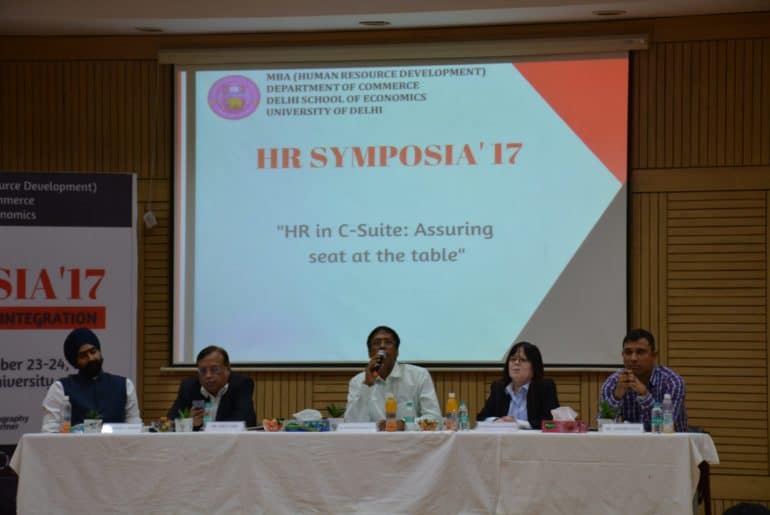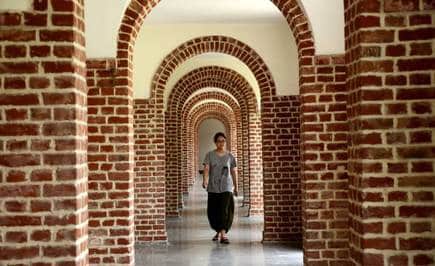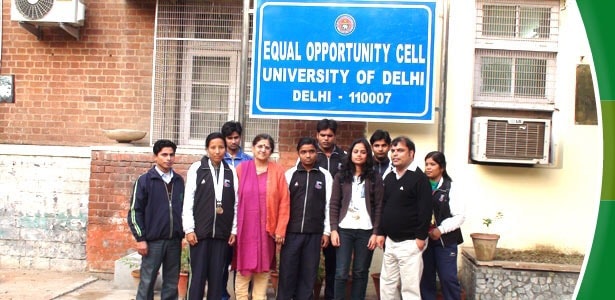HR Symposia 2017, one of the most awaited events of MBA (HRD) Department of Commerce, Delhi School of Economics kick-started on 23rd September 2017. The theme for HR Symposia 2017 was ‘Techcelerating HR: Forging Integration’.
The first day of the two-day extravaganza commenced with the inaugural lamp lighting ceremony by Dr. Urvashi Sharma, Course Coordinator, MBA (HRD) along with our esteemed guest speakers, Ms. Ira Singhal, who is an IAS officer and Mr. Alok Nigam who is the Group CHRO, Bhartiya Group. Ms. Ira Singhal started her keynote emphasizing upon the importance of HR’s role in any organization. She described how HR has the ability to create an impact in other people’s lives. “To succeed in HR, one should be a silent warrior.” she quoted. Mr. Alok Nigam took the stage and started with his address with the fact that one must have a lifelong yearning to learn new things, calling himself an eternal student. He further continued talking about the essentials an HR manager must keep in mind. “Practice doesn’t make a man perfect, it makes a man better” he quoted.
Soon after, we had on stage, Mr. Jaspreet Bakshi, Director & Regional Head, HR People Services India, Royal Bank of Scotland. Mr. Bakshi talked about how the technology is going to drive the businesses in future. He shed some light on the recent trends which have enabled the organizations to transform the traditional workspace setup. “Focus on value, not on raw data” he quoted. Shortly, Mr. Bakshi was joined by Mr. Arindam Chakraborty, VP-HR of Eicher Polaris, Mr. Kiriti Sen, Life, Career and Relationship Coach, Winged Bird, Ms. Rashmi Mansharmani, Corporate Head – HR, The Wave Group, Mr. Govind Negi, Director – Talent Engagement India, 3Pillar Global – India for the first panel discussion of the day which was on the topic, “HR in C-Suite: Assuring Seat at the Table”.
The panel started the discussion highlighting the fact that HR is no longer a support function and has become a growth enabler in business. They talked about how crucial it is for the HR managers to have an in-depth understanding of the business they are a part of so as to enhance their influence in the business. They also discussed various challenges the businesses are facing in the present day and how HR can help them provide fruitful solutions to them. The panel discussion concluded with an interactive Q&A session between the students and panelists.
After the panel discussion, we welcomed Mr. Paras Kaushik, VP-HR, Aditya Birla Group for the Speaker Session on the topic ‘Design Thinking in Tech HR’. Mr. Kaushik explained in detail about what Design Thinking is all about with real-life examples and experience sharing. He emphasized on how Design Thinking is more about the mindset than just the process. He also briefed upon the key elements of design thinking. In the end, there was an interactive session between Mr. Kaushik and students to get further insights on Design Thinking and its future implications. “Ownership of product leads to more responsible use and care of the product, increasing productive usage.” he quoted. After Mr. Kaushik, we welcomed Mr. Prasad Kulkarni, Head HR – Shared Services and C &B, Raymonds Ltd., Mr. Avadhesh Dixit, Head Global HR, Moody’s Analytics Knowledge Services and an MHROD Alumnus 1999 Batch, Mr. Gaurav Saini, HR Director – India & MENA Region, HMD Global (Nokia), Mr. Rajneesh Singh, Managing Partner, SimplyHR Solutions and Mr. Rupesh Tripathi, Head HR, IHS Markit for the second panel discussion of the day. The topic for discussion was ‘VUCA Times and Technology: Finding Solutions’.
The discussion began with the panelists discussing how technology should be seen as a facilitator to problem-solving instead of making things complex. To adapt to the fast-changing technology, there has to be a change in the mindset of people. Panelists were of the view that VUCA times need to be embraced rather than feared. Each speaker of the panel shared their own experience and guided the students in the interactive Q&A session which was an extremely enlightening experience for the students.
After a very interesting first day, the second day saw the excitement and enthusiasm of the participants soaring high!
The first session of the day was a panel discussion. In keeping with the theme of the event- “Techcelerating HR: Forging Integration”, the topic of discussion was “Optimizing HR: Augmented Workforce. The panel included Mr. Ashok Kumar Rai, Director Human Resources at Aricent, Mr. Biplob Banerjee, Executive VP – HR and CSR at Jubilant FoodWorks Ltd., Mr. Sanjeev Sharan, Director- HR- Globalization at ZTE Telecom Ltd and Mr. Manoj Sharma, Senior VP – HR at RG Group.
The discussion began on a very interesting note where the moderator, Mr. Banerjee introduced the panelists and opened the discussion by delving into what augmented workforce means. The discussion was taken forward by Mr. Douglas Peter who put forth the observation that in today’s changing industry, it is the HR manager who holds the power to actually implement policies and add value to the business in the bigger picture of things. The rest of the panelists spoke along the same lines, agreeing to the common fact that while the change is really fast-paced, the role of HR is all about adapting to that change.
The second session of the day was another highly intriguing panel discussion on the topic, “Digitalization and Disruptive Leadership”. The panelists included Mr. Mukesh Batra, Head HR at MothersonSumi Infotech & Designs Ltd., Mr. Anurag Srivastav, Co-founder of PayReview, Mr. Vikash Dubey, Head HR – Services BU at Persistent Systems, Mr. Ashutosh Sharma, Head HR at Paras Buildtech and Mr. Snehashish Bhattacharyya, VP-HR at VLCC Person Care Ltd. The panel gave some insightful views on the topic, with Mr. Batra moderating the session for the house.
The topic of discussion for the session is currently a highly relative one with more and more organizations moving towards Disruptive Leadership. This is impacting the role and functioning of the HR manager majorly as organizations today are becoming boundary-less, making them very susceptible to the technological changes happening in present times. The key takeaway from this session was that prospective HR professionals need to be ready to think of the unthinkable to survive this disruption and simultaneously work towards improving the experience of the end-user.
The panel discussion was followed by Mr. Vikash Dubey, Head HR – Services BU at Persistent Systems addressing the house. Taking a cue from the discussion that took place in the previous session, Mr. Dubey went on to explain more categorically how the role of an HR is evolving. He emphasized the importance of staying conceptually strong and tech-savvy at the same time for any HR manager today. Maintaining that human connect will always be the core responsibility of an HR manager is what he concluded his address with.
The final session of the day and the event saw an extremely interactive and exciting panel discussion on the topic- “Cognifying HR and Social media”. The panelists comprised Mr. Narendra Chandel, Head, Talent Acquisition, North India at Tata Consultancy Services, Mr. Rakesh Seth, Director of ICPI, Ms. Harpreet Datta, Sr. Vice President / Head – Human Resources at The Princeton Review, Mr. Deepak Bharara, CHRO at LANCO, Mr. A.K. Munjal, VP-HR at Maruti Suzuki and Ms. Amrita Singh, Senior Manager- HR at Godrej. The discussion was moderated by the high-spirited veteran speaker, Mr. Deepak Bharara.
The session started with each panelist presenting their take on the topic of discussion. They all agreed to the fact that data today is the new oil and social media has changed the way we are communicating in our personal as well as professional lives. HR roles have been transforming to accommodate all these changes, and while the use of technology has eased out things, it can in no way replace the HR manager.
Mr. Bharara made the session very interesting by giving the panelists a pop quiz. It was really interesting and informative to listen to the panelists answering his questions to the best of their abilities and experience.
Day 2 of HR Symposia ’17 ended with the Convenor of the organizing committee, Student Development Cell, Khushboo Mandal declaring the event officially closed. The participating students were definitely left richer by the experience and knowledge shared by the speakers of the event. HR Symposia ’17 concluded on a successful note, with the anticipation of something bigger happening in the coming year!
Image Credits: Department of Commerce, DSE

